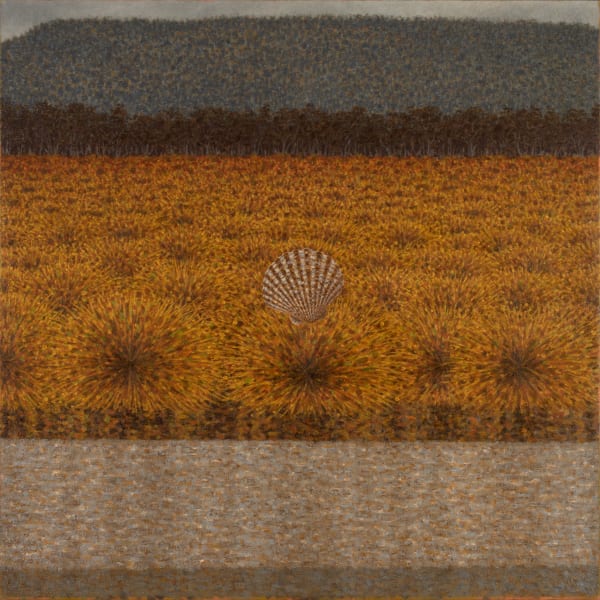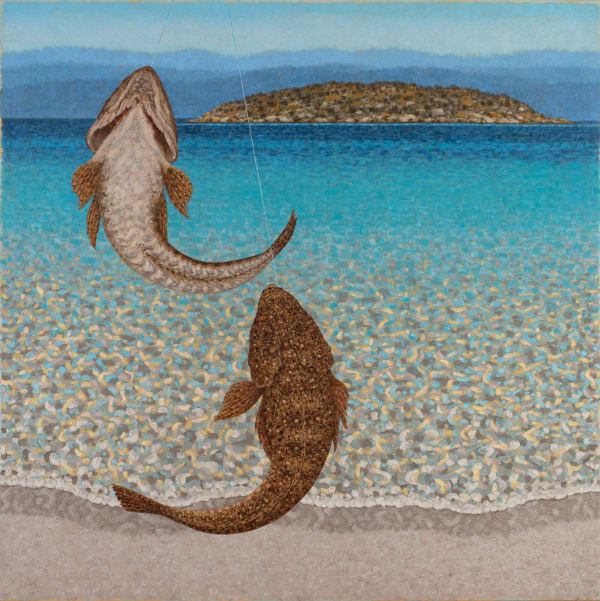Painting East from the Plateau
Richard Wastell’s enigmatic works render the Tasmanian landscape with such veracity that they are almost otherworldly. He has earned his reputation as a master of composition for large works, across multiple panels, in which elements of interest and admiration are pulled forward for artistic study. These magnified details—insects, shells, lichens, the patterned bark of tree trunks, the soft spines of a cushion plant—give Wastell’s works a uniquely exaggerated first-person perspective. The artist places us where he has stood; we are irrevocably embedded in his reality, enveloped in his deep reverence for the bush.
Perspective is as much a conceptual concern as it is a formal technique for the artist, whose love of painting is paralleled only by his love for the wilderness. The works are as complex and multifaceted as any act of looking, watching, witnessing. There is a deep and dark lament in the scorching of tree ferns after the clear-felling. There is burning joy in the sun that sets the grasslands ablaze at dusk. And there is a stillness and a deep satisfaction in the rippling lakes, the smouldering campfires and the fresh-caught trout in the falling darkness of late summer.
I grew up on the beaches of South East Tasmania. The Family home was at Seven Mile Beach and our weekends and holidays were spent at shacks and campsites up and down the East Coast from Eaglehawk Neck to Freycinet Peninsula. At other holiday times, when I wasn't at the beach, I'd be camping and fishing for trout all over the central plateau, at Lake Sorell, Arthurs and Woods lake in particular. These two environments, the East Coast and the lake Country have had a profound impact on me over the years, so that I think of those two special places as constituting my home range. I return to them again and again, in all weathers and seasons, for refuge, for hope, to remember, for their restorative powers and for what they still have to teach me about myself, the world and my place in it. This is what my new paintings are about.
While my work about the Lake Country has been a long-term companion, my East Coast works are a newer development. They came into being in part, perhaps not surprisingly, as a personal response to the Global Covid Pandemic. When lockdown happened in Tasmania around Easter last year, I was at home with the kids anxiously waiting for what seemed to be the inevitable viral apocalypse to arrive and wipe us all out. All I wanted to do was go for a swim up the East Coast of Tasmania, to walk under the blue skies in the sun, across brilliant quartzite sand and to wade into that beautiful clear turquoise water the colour of good health and let it swallow me up. If ever a stretch of land and sea could be a panacea of vitality, the East Coast appeared to be it. But that swim was not to be. I made do with a daily walk or a bike ride with the kids up and down the empty streets of Lutana and began a painting of the northern end of Friendly Beaches as a substitute for the real thing. I'd never used those colours before and those particular green/blue hues were a joy and a challenge to mix and to apply layer upon layer, searching for the right tone. Can painting have a medicinal effect I wondered? Indigenous cultures the world over seem to believe in the magic and power of the image to transport, to heal and to protect. I'm sure that I'm a believer in the magic and mysterious power of painting 'East from the Plateau'. Paintings from the East Coast will hang side by side with painting from the Lake Country. I'll be interested to hear what others make of that relationship.
Richard Wastell
July, 2021
Email the gallery to express your interest in Richard's practice
-
 Richard WastellTravelling song, East to West, 2021oil and pumice on linen153 x 153cm ( stretcher size )Sold
Richard WastellTravelling song, East to West, 2021oil and pumice on linen153 x 153cm ( stretcher size )Sold -
 Richard WastellWanting to go for a swim at Friendly Beaches, 2021oil and pumice on linen153 x 153cm ( stretcher size )Sold
Richard WastellWanting to go for a swim at Friendly Beaches, 2021oil and pumice on linen153 x 153cm ( stretcher size )Sold -
 Richard WastellOld ways, new mornings at Lake Sorell, 2021oil and pumice on linen153 x 153cm ( stretcher size )Sold
Richard WastellOld ways, new mornings at Lake Sorell, 2021oil and pumice on linen153 x 153cm ( stretcher size )Sold -
 Richard Wastell and James DryburghThoughts from a rock on Great Oyster Bay, 2021oil and pumice on linen153 x 153 cm (stretcher size)Sold
Richard Wastell and James DryburghThoughts from a rock on Great Oyster Bay, 2021oil and pumice on linen153 x 153 cm (stretcher size)Sold -
 Richard WastellLizards off Refuge Island, 2021oil and pumice on linen153 x 153cm ( stretcher size )Sold
Richard WastellLizards off Refuge Island, 2021oil and pumice on linen153 x 153cm ( stretcher size )Sold -
 Richard WastellTrout landed at the edge of The Marsh, 2021oil and pumice on linen153 x 153cm ( stretcher size )Sold
Richard WastellTrout landed at the edge of The Marsh, 2021oil and pumice on linen153 x 153cm ( stretcher size )Sold -
 Richard WastellTripod and light - nearing dusk at Woods Lake, 2021oil and pumice on linen153 x 153cm ( stretcher size )Sold
Richard WastellTripod and light - nearing dusk at Woods Lake, 2021oil and pumice on linen153 x 153cm ( stretcher size )Sold -
 Richard WastellEast Coast ground swell and shell fragments, 2021oil and pumice on linen153 x 153cm ( stretcher size )Sold
Richard WastellEast Coast ground swell and shell fragments, 2021oil and pumice on linen153 x 153cm ( stretcher size )Sold
















